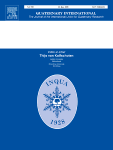Ver ítem
- xmlui.general.dspace_homeCentros Regionales y EEAsCentro Regional Tucumán - Santiago del EsteroEEA Santiago del EsteroArtículos científicosxmlui.ArtifactBrowser.ItemViewer.trail
- Inicio
- Centros Regionales y EEAs
- Centro Regional Tucumán - Santiago del Estero
- EEA Santiago del Estero
- Artículos científicos
- Ver ítem
Charred wood and plant microremains associated to Neosclerocalyptus sp. (Cingulata, Chlamyphoriidae, Glyptodontinae) from the Upper Pleistocene of Western Chaco, Argentina
Resumen
The Chaco Region is the third biogeographic and morpho-structural territory of South America after the Amazon and Cerrado savannahs. This Region is one of the few areas in the world where the transition from the tropics to temperate zones does not consist of a desert but of semi-arid woodlands and savannahs. The modern biodiversity patterns of the region were severely affected by the climatic and environmental changes that occurred during the Quaternary.
[ver mas...]
The Chaco Region is the third biogeographic and morpho-structural territory of South America after the Amazon and Cerrado savannahs. This Region is one of the few areas in the world where the transition from the tropics to temperate zones does not consist of a desert but of semi-arid woodlands and savannahs. The modern biodiversity patterns of the region were severely affected by the climatic and environmental changes that occurred during the Quaternary. Remains of an extinct megamammal Neosclerocalyptus sp. (Upper Pleistocene) and charred fossil woods inside of sedimentary nodules, was recently discovered in Chaco Argentina. The aim of paper is the paleoenvironmental reconstruction of quaternary sedimentation in the western Chaco through the taxonomic identification of charred woods and siliceous microfossils analysis. Twenty-three charcoal fragments related to Anacardiaceae, Apocynaceae, Fabaceae, Rhamnaceae and Malvaceae were identified. The phytolith analysis showed that Poaceae elements were the most abundant compared to the other herbaceous and non-herbaceous elements, along with algae and sponge microfossils. Eco-anatomic features of the charcoals and the microfossil remains suggest that environment and climate conditions existed in the area during the Upper Pleistocene were similar to the current one. Finally, the results reveal the presence of natural wildfires during the Quaternary in the region.
[Cerrar]

Autor
Ramos, R. Soledad;
Contreras, Silvina A.;
Vezzosi, Raúl;
Leon, D. Catriel;
Tasso, Juan Cruz;
Fuente
Quaternary International (Available online 4 August 2020)
Fecha
2020-08
Editorial
Elsevier
ISSN
1040-6182
Formato
pdf
Tipo de documento
artículo
Palabras Claves
Derechos de acceso
Embargado
 Excepto donde se diga explicitamente, este item se publica bajo la siguiente descripción: Creative Commons Attribution-NonCommercial-ShareAlike 2.5 Unported (CC BY-NC-SA 2.5)
Excepto donde se diga explicitamente, este item se publica bajo la siguiente descripción: Creative Commons Attribution-NonCommercial-ShareAlike 2.5 Unported (CC BY-NC-SA 2.5)

